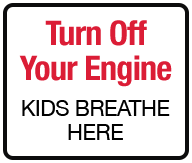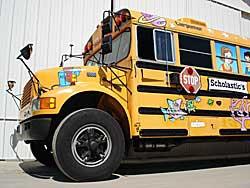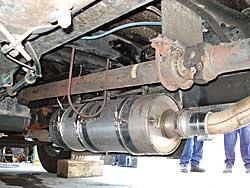Clean School Bus
School buses travel about four billion miles each year, providing the safest transportation to and from school for more than 25 million American children every day. However, diesel exhaust from these buses has a negative impact on human health, especially for children who have a faster breathing rate than adults and whose lungs are not yet fully developed.
While new buses must meet EPA’s tougher emission standards, many older school buses continue to emit harmful diesel exhaust. EPA's Clean School Bus is a national program designed to help communities reduce emissions from older diesel school buses. School districts, fleet owners and operators, bus drivers, parents and students all have a role in helping to reduce diesel emissions from school buses.
EPA offers funding, as appropriated annually by Congress, for projects that reduce emissions from existing diesel engines. EPA also provides information on strategies for reducing emissions from older school buses. One of the easiest ways to reduce school bus emissions and save money is to reduce idling. Another effective method is to replace the oldest school buses in the fleet.
School Bus Rebate Program
In January 2011, President Obama signed the Diesel Emissions Reduction Act of 2010 (PDF) (7 pp, 133 K, January 2011, About PDF), reauthorizing DERA through fiscal year 2016 and allowing EPA to offer rebates in addition to grants.
2015 School Bus Rebate Program
2014 School Bus Rebate Program
2012 School Bus Rebate Program
Resources
Printed Clean School Bus publications can be ordered from the National Service Center for Environmental Publications.
- The Magic School Bus Gets Cleaned Up
- El Autobus Mágico Necesita Una Limpieza
- Tomorrow’s Buses for Today’s Children (PDF) (4 pp, 420 K, August 2010, EPA-420-F-10-019 About PDF)
- 25 Million Reasons Why It's Important to Reduce Idling (PDF) (6 pp, 410 K, April 2006, EPA-420-F-06-018, About PDF)
- Reducing School Bus Idling: Clean Air Poster (PDF) (22 inches high x 34 inches wide) (1 pg, 3 MB, April 2006, EPA-420-H-06-001, About PDF)
- Reducing School Bus Idling: The Key to a Healthier Ride Video (CD Video) (April 2004, EPA-420-C-04-001) - Click on US Postal graphic to access order form
- Carl Gets Some Rest (PDF) (12 pp, 783 K, April 2003, EPA-420-K-03-001, About PDF)
- EPA's Region 8 Idle Free Schools Toolkit
- EPA's Protecting Children's Environmental Health
- EPA's Healthy Schools, Healthy Kids
- EPA's Healthy School Buildings
The following links exit the site Exit
Idle Reduction Campaign
Clean School Bus's National Idle Reduction Campaign helps you take action toward a cleaner, healthier environment. The key to reducing idling is you!
- Why Idle Reduction Matters
- Idling Myths
- Participate in the National Idle Reduction Campaign
- Idling Reduction Technologies
Why Idle Reduction Matters
Unnecessary school bus idling affects human health, pollutes the air, wastes fuel, and causes excess engine wear. Fortunately, it's easy to implement practices that reduce school bus idling.
Human Health Impacts
Diesel exhaust contains significant levels of particles, known as fine particulate matter (PM), which are so small that several thousand of them could fit on the period at the end of this sentence. These fine particles pose a significant health risk because they can pass through the nose and throat and lodge in the lungs. Children are more susceptible than healthy adults because their respiratory systems are still developing and they have a faster breathing rate. Children, the elderly and people with existing heart or lung disease, asthma, bronchitis or other respiratory problems are most at risk.
Air Pollution
Idling school buses can pollute air in and around the bus. Exhaust from buses can also enter school buildings through air intakes, doors, and open windows. Diesel exhaust contains pollutants that contribute to
Wasted Fuel and Money
Idling buses waste fuel and money. School districts that eliminate unnecessary idling can have significant savings in fuel costs each year.
Engine Wear-and-Tear
School bus engines do not need to idle more than a few minutes to warm up. In fact, extended idling causes engine damage. Engine manufacturers generally recommend no more than three to five minutes of idling.
Idling Myths
Myth: It's important to warm up the engine with a long idle period, especially in cold weather.
Fact: With today's school bus engines, bus and engine manufacturers routinely suggest a warm up time of less than five minutes.
Myth: It's better for an engine to run at low speed (idling) than to run at regular speed.
Fact: Running an engine at low speed causes twice the wear on internal parts as driving at regular speeds.
Myth: Idling is necessary to keep the cabin comfortable.
Fact: Many buses maintain a comfortable interior temperature for a while without idling. Bus routes should be timed so children and drivers do not need to spend a lot of extra time on the bus when it is not en route, particularly in hot or cold weather. Auxiliary heaters can be purchased and installed to keep the cabin comfortable.
Myth: It’s better to leave the engine idling because a "cold start" produces more pollution.
Fact: Continuous idling for more than three minutes emits more fine particles (soot) than a restart. Emissions after a restart contain less carbon monoxide, nitrogen oxides, and other pollutants than if the school bus idled continuously over a 10-minute period.
Participate in the National Idle Reduction Campaign
1. Establish an Idle Reduction Policy
Here is a sample School Bus Idling Policy (DOC)(1 pg, 16 K) you can use as a model.
At a minimum, the policy should include the following:
- Buses should typically be moving whenever the engine is on.
- Engines should be turned off as soon as possible after arriving at loading or unloading areas.
- School buses should not be restarted until ready to depart.
- Limit idling time during early morning warm up to what the manufacturer recommends (generally no more than five minutes).
Tips to help your idle reduction policy succeed include:
- Train bus drivers to understand and follow the idle reduction policy.
- Provide a comfortable space inside where bus drivers can wait.
- Spot-check loading and unloading areas, delivery areas and bus depots for compliance with the idling guidelines.
- Consider idle reduction technologies to help with cabin comfort and equipment operation.
- Follow idling laws and guidelines in your state or community, where applicable. See the Compendium of Idling Regulations (2015) (PDF)(12 pp, 400 K, About PDF) Exit
2. Promote your Idle Reduction Campaign
Clean School Bus's National Idle Reduction Campaign offers a selection of materials that can be ordered from the National Service Center for Environmental Publications or downloaded.
- The Magic School Bus Gets Cleaned Up
- El Autobus Mágico Necesita Una Limpieza (opens in new tab or window)
- Tomorrow’s Buses for Today’s Children (PDF)(4 pp, 420 K, August 2010, EPA-420-F-10-019) About PDF)
- 25 Million Reasons Why It's Important to Reduce Idling (PDF)(6 pp, 410 K, April 2006, EPA-420-F-06-018, About PDF)
- Reducing School Bus Idling: Clean Air Poster (PDF) (22 inches high x 34 inches wide) (1 pg, 3 MB, April 2006, EPA-420-H-06-001, About PDF)
- Reducing School Bus Idling: The Key to a Healthier Ride (CD Video)(April 2004, EPA-420-C-04-001)
3. Sustain and expand your Idle Reduction Program
Recognize drivers who successfully reduce idling.
- Award drivers with a certificate of recognition.
- Ask local businesses, non-profits working on clean air, or parent/teacher organizations to donate gift certificates or other items to reward bus drivers who successfully reduce idling.
Urge your community leaders to issue a local Idle Reduction Proclamation (DOC)(1 pg, 14 K) .
Share your success with other school districts, the media and the general public by issuing a press release (DOC)(1 pg, 14 K) about your program.
Idling Reduction Technologies
Idle reduction technologies and engine-off auxiliary heaters reduce emissions by minimizing the amount of time an engine operates. To learn more about idling reduction technologies verified by EPA, visit SmartWay Idle Reduction Technologies.
Engine-off auxiliary heaters can be used to warm engines and passenger compartments in colder climates. These heaters run off diesel fuel or electric outlets and include a programmable timer to automatically start or stop the heating function. Benefits of these heaters are fuel savings, lower emissions, longer oil life, less wear-and-tear on the engine, and relatively easy installation and maintenance. There are three types of heaters:
- Fuel-Operated Engine Block Heaters heat the engine block for a warm start. Each block pre-heater uses only half a cup of diesel per hour compared to half a gallon or more per hour while idling. They can be used where electrical block heaters are not feasible.
- Electric Plug-in Block Heaters warm the engine block by heating the engine coolant or oil. They are powered by electricity and are available in a range of voltages and watts. A heater is mounted on the engine block and plugged in when the bus is parked at the depot, allowing for a warm start. Bus depots and garages can be designed or retrofitted to bring in the electrical service required.
- Compartment and Engine Block Heaters warm the engine block and passenger compartment simultaneously using an auxiliary heater. These heaters use only one cup of fuel per hour compared to half a gallon of fuel needed to idle for an hour. They are especially useful for nighttime-activity and buses that transport very young and/or special-needs children. In addition, the radiant heat improves safety by preventing the windows from frosting or fogging.
On this page:
Replacing Old School Buses
Older, more polluting school buses can lead to significant health risks for students who typically ride these buses for one-half to two hours a day. Children are more susceptible to air pollution than healthy adults because their respiratory systems are still developing and they have faster breathing rates. Asthma, which affects 6.3 million American school children, is the most common long-term childhood disease in America, making newer, cleaner buses an urgent priority.
In addition to affecting the health of students, emissions from older buses can have a negative impact on the whole community. Particulate matter (PM) damages hearts and lungs. Other diesel emissions contribute to
Older buses are excellent candidates for replacement with newer, cleaner vehicles which will greatly reduce children’s exposure to diesel exhaust and provide considerable safety improvements. To see if there is a school bus replacement or retrofit rebate currently available, please visit Clean Diesel Rebates.
Reviewing Age and Condition of Bus Fleet
Districts should assess the buses in their fleet for age and condition to determine which buses need to be replaced first. Compiling this information in advance allows districts to plan for future expenditures and to be prepared when funds become available. Fleet information can be collected on a Fleet Information Table (XLS)(1 pg, 26 K, June 2012) .
Prioritizing School Bus Replacements
Targeting pre-1998 school buses for replacement is not only key to retiring buses that pollute the most, but is also a cost-effective strategy. Older buses often have increased maintenance concerns, decreased fuel economy benefits, and less stringent safety equipment. Below are groupings of engine model years in order of replacement priority.
- Pre-1998
- 1998-2003
- 2004-2006
- Post 2007
Buses Built Before 1998
Buses built before 1998 that are used for student transport should be ranked as a high priority for replacement. Consider using them on shorter routes, for special events or as emergency back-ups to limit student exposure until they can be replaced. Implement an idle reduction program and keep the engines in good working order.
Buses Built Between 1998 and 2010
If school buses built between 1998 and 2010 are still in use, there are ways to reduce the emissions they produce.
- Idle Reduction - Implementing an idle reduction program is a simple, cost-effective way to reduce emissions while saving money on fuel and preventing engine wear and tear.
- Retrofit Technologies - For older buses that will be used for several more years, retrofitting them with emission controls or idle reduction technologies can be a cost effective way to reduce emissions.
- Engine Replacements - Older diesel engines can be replaced with newer engines using diesel, biodiesel or compressed natural gas (CNG). The new engine should be certified to meet the most recent emission standards and come with a diesel particulate filter (DPF) or diesel oxidation catalyst (DOC).
- Fuel Selection - Cleaner fuels such as biodiesel or compressed natural gas (CNG) can further reduce emissions from school buses.
When replacing buses built between 1998 and 2010, the school district should check with nearby districts. If the neighboring districts are operating older buses and can’t afford brand new buses, they may be able to use the relatively newer buses as a replacement alternative. Overall, this is a win-win situation for the whole community.
Bid Specifications
Bid specifications for new bus purchases should require information about the emission levels of the new, certified bus engines and specify any additional technologies available to further reduce those levels. Additional bus safety considerations should be also be included as a part of the specification process.
Finding Financing for Cleaner Buses
Although some communities have schedules for replacing school buses, they may not have the resources to do so as quickly as they would like. By assessing the fleet age and condition, the school district will be more prepared to apply for available funding. Fleet information can be collected on Fleet Information Table (XLS)(1 pg, 26 K, June 2012) .
Outside funding sources may require or recommend the school district to provide matching funds using financial or other resources. Try to determine the school district’s available resources, whether in-kind (such as staff time) or financial, that could be used as a match for the funds.
If funding is limited, try to identify districts that are replacing their buses. The buses being replaced may be relatively newer and purchasing them could result in overall emission reductions for the school district.
What You Can Do
Everyone has a role in reducing emissions from school buses.
School Officials
- Establish idle reduction policies
- Work with bus companies to ensure idle reduction policies are implemented
- Discourage drivers from following directly behind other school buses or large vehicles, especially if they are emitting visible smoke
- Deploy cleanest buses on longest routes
- Shorten commute times for children, if possible
- Minimize the time children spend outside when school buses are arriving or departing
- Provide a space inside the school where drivers can wait on cold days
- Post no-idling signs on school grounds
- Limit idling of delivery vehicles on school grounds
- Develop educational programs for students about air pollution
Bus Owners / Operators
- Implement idle reduction policies
- Educate drivers and give recognition to drivers who reduce idling times
- Discourage drivers from following directly behind other school buses or large vehicles, especially if they are emitting visible smoke
- Take steps to retrofit existing buses with pollution controls and idle reduction devices
- Keep buses well maintained
- Replace the oldest buses with newer, cleaner buses
Bus Drivers
- Follow idle reduction guidelines established by school officials and/or bus owners
- When standing, turn off the school bus engine
- Avoid following directly behind other school buses or large vehicles, especially if they are emitting visible smoke
Parents
- Talk with school officials about establishing idle reduction programs
- Talk with school transportation providers about establishing idle reduction programs
- Do not idle your personal vehicle
Students
- Talk with school officials about reducing school bus idling
- Talk with bus drivers about idle reduction
- Help school officials make and post no-idling signs
"The Magic School Bus Gets Cleaned Up"
Link to Spanish publication - "El Autobus Mágico Necesita Una Limpieza"
 Publication Number: EPA-420-K-07-001
Publication Number: EPA-420-K-07-001
To order: Phone: 800-490-9198 · Email: nscep@lmsolas.com · Fax: 301-604-3408EPA, in collaboration with Scholastic, has created a new book in the popular "Magic School Bus" series for children. In these acclaimed educational books and videos, Ms. Frizzle takes her class on science-oriented field trips, riding their magical school bus.
In "The Magic School Bus Gets Cleaned Up," the children and Ms. Frizzle explore the pollution emitted from their own diesel school bus and learn how to reduce emissions as they travel through the diesel engine. The children learn about idle reduction and other ways to reduce health risks from diesel exhaust. At the end of the book, the "Magic School Bus" gets its own pollution control device, a diesel particulate matter filter.
Quantities are limited due to the popularity of the book.
- Individuals, schools and libraries may order one copy each at no charge.
- Non-profit organizations and state and local governments working on diesel and clean air education may request more. Approval is on a case-by-case basis.
Real Magic School Bus Gets a Retrofit
Based on the magical yellow school bus in the "Magic School Bus" series, Scholastic operates a traveling science laboratory Exit housed in a yellow school bus. The bus tours the United States, offering hands-on science lessons to children at schools, fairs, and other community events.
Following the story line of "The Magic School Bus Gets Cleaned Up," this traveling bus was retrofitted with a diesel particulate filter, reducing particulate matter by up to 90%.
 Scholastic's traveling Magic School Bus is equipped with a diesel particulate filter donated by Caterpillar.
Scholastic's traveling Magic School Bus is equipped with a diesel particulate filter donated by Caterpillar. Undercarriage view of the diesel particulate filter that was installed on the traveling Magic School Bus.
Undercarriage view of the diesel particulate filter that was installed on the traveling Magic School Bus.